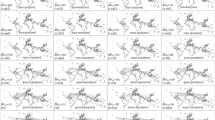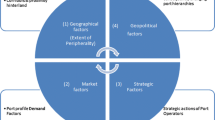Abstract
Port and maritime studies dealing with containerization have observed close correlation between global liner shipping and world trade, and centrality in global shipping network (GSN) may change as the situation of world economy and trade changes. Meanwhile, the influence that shipping areas have on the GSN is much greater than any single port, and connections between these shipping areas affect the structure of the GSN. This paper wishes to understand the dynamic changing of the centrality in the GSN during the period from 2001 to 2012, which sees both booms and depressions in world economy and liner shipping. The paper divides global shipping into 25 areas from geographical perspective, and presents an analysis of each shipping area’s position in the GSN through indicators of centrality. The results reveal that to a large extent Europe is always in the center of the GSN from 2001 to 2012, but its central position is declining. Additionally, mapping the centrality distribution of those shipping areas in the latest year confirms their current positions in the GSN.














Similar content being viewed by others
Notes
Alphaliner. http://www.alphaliner.com/.
A measure of dominance of the most central point (also called graph centrality) by Freeman is \( {\text{C}}_{\text{X}} = \frac{{\sum\nolimits_{{{\text{i}} = 1}}^{\text{n}} {\left( {{\text{C}}_{\text{X}} \left( {{\text{p}}^{\text{n}} } \right) - {\text{C}}_{\text{X}} \left( {{\text{p}}_{\text{i}} } \right)} \right)} }}{{\hbox{max} \sum\nolimits_{{{\text{i}} = 1}}^{\text{n}} {\left( {{\text{C}}_{\text{X}} \left( {{\text{p}}^{\text{n}} } \right) - {\text{C}}_{\text{X}} \left( {{\text{p}}_{\text{i}} } \right)} \right)} }} \) where CX is defined according to degree, betweenness and closeness respectively, CX(p*) is the largest centrality value associated with any point in the graph under investigation, and \( \hbox{max} \sum\nolimits_{{{\text{i}} = 1}}^{\text{n}} {\left( {{\text{C}}_{\text{X}} \left( {{\text{p}}^{*} } \right) - {\text{C}}_{\text{X}} \left( {{\text{p}}_{\text{i}} } \right)} \right)} \) is the difference in centrality between the most central point and all others in a star or a wheel.
References
Ducruet, C., Lee, S. W., & Adolf, K. Y. N. (2010a). Centrality and vulnerability in liner shipping networks: Revisiting the Northeast Asian port hierarchy. Maritime Policy & Management: The flag ship journal of international shipping and port research, 37(1), 17–36. doi:10.1080/03088830903461175.
Ducruet, C., Rozenblat, C., & Zaidi, F. (2010b). Ports in multi-level maritime networks: Evidence from the Atlantic (1996–2006). Journal of Transport Geography, 18(4), 508–518. doi:10.1016/j.jtrangeo.2010.03.005.
Ducruet, C., & Notteboom, T. (2012). The worldwide maritime network of container shipping: Spatial structure and regional dynamics. Global Networks, 12(3), 395–423. doi:10.1111/j.1471-0374.2012.00352.x.
Ducruet, C., & Zaidi, F. (2012). Maritime constellations: a complex network approach to shipping and ports. Maritime Policy & Management: The flag ship journal of international shipping and port research, 39(2), 151–168. doi:10.1080/03088839.2011.650718.
Ferber, C. V., Holovatch, Y., & Palchykov, V. (2005). Scaling in public transport networks. Condensed Matter Physics, 8(1), 225–234. doi:10.5488/CMP.8.1.225.
Freeman, L. C. (1979). Centrality in Social networks conceptual clarification. Social Networks, 1(3), 215–239. doi:10.1016/0378-8733(78)90021-7.
Hu, Y. H., & Zhu, D. L. (2009). Empirical analysis of the worldwide maritime transportation network. Physica A, 388(10), 2061–2071. doi:10.1016/j.physa.2008.12.016.
Mu, X. W., & Chen, Y. (2009). Topological features of liner shipping network. Journal of Dalian Maritime University, 35(2), 34–37. doi:http://caod.oriprobe.com/articles/32273617/Topological_features_of_liner_shipping_network.htm. (in Chinese).
Pablo, K., Andrea, K., et al. (2010). The complex network of global cargo ship movements. Journal of the Royal Society, Interface, 7(Suppl_2), 1093–1103. doi:10.1098/rsif.2009.0495.
Robert, M., Brian, S., & Claude, C. (2005). The Caribbean Basin: Adjusting to global trends in containerization. Maritime Policy & Management: The flag ship journal of international shipping and port research, 32(3), 245–261. doi:10.1080/03088830500139729.
Rodrigue, J. P., & Notteboom, T. (2010). Foreland-based regionalization: Integrating intermediate hubs with port hinterlands. Research in Transportation Economics, 27(1), 19–29. doi:10.1016/j.retrec.2009.12.004.
Sen, P., Dasgupta, S., et al. (2003). Small-world properties of the Indian railway network. Physical Review E, 67(3), 036106. doi:10.1103/PhysRevE.67.036106.
Tian, W., Deng, G. S., et al. (2007). Analysis of complexity in global shipping network. Journal of Dalian University of Technology, 47(4), 605–609. doi:http://en.cnki.com.cn/Article_en/CJFDTOTAL-DLLG200704027.htm. (in Chinese).
Wu, P. J., Deng, G. S., & Tian, W. (2008). Research on topology character of container shipping network. Journal of Wuhan University of Technology (Transportation Science &Engineering), 32(4), 665–668. (in Chinese).
Xu, X. P., Hu, J. H., & Liu, F. (2007). Empirical analysis of the ship-transport network of China. Chaos, 17(2), 023129. doi:10.1063/1.2740564.
Acknowledgments
Authors are grateful to anonymous reviewers for their useful comments on this paper. This research benefited from the financial support of National Natural Science Foundation of China and National Social Science Foundation of China.
Author information
Authors and Affiliations
Corresponding author
Rights and permissions
About this article
Cite this article
Li, Z., Xu, M. & Shi, Y. Centrality in global shipping network basing on worldwide shipping areas. GeoJournal 80, 47–60 (2015). https://doi.org/10.1007/s10708-014-9524-3
Published:
Issue Date:
DOI: https://doi.org/10.1007/s10708-014-9524-3




